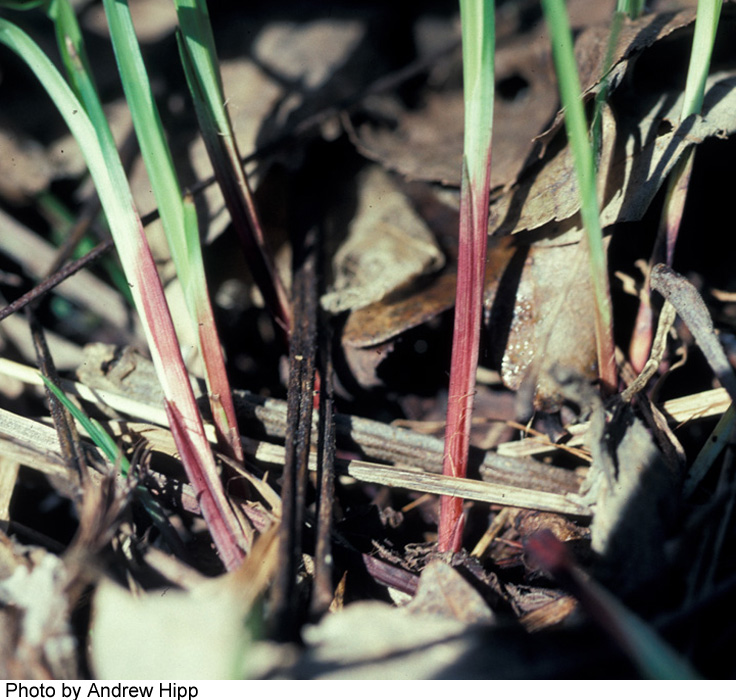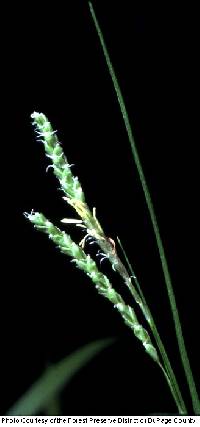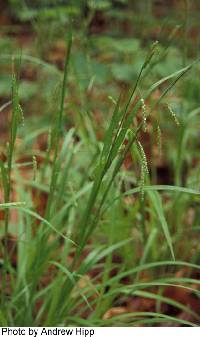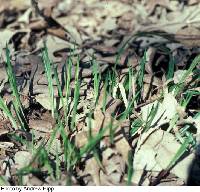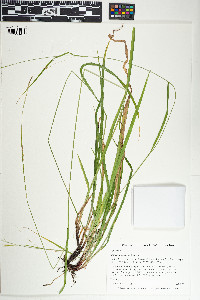|
|
|
|
Family: Cyperaceae
graceful sedge
[Carex gracillima var. macerrima Fernald & Wiegand] |
Plants densely cespitose. Culms dark maroon at base; flowering stems 0.5-1.1 mm thick, 20-90 cm, much longer than leaves at maturity, glabrous, but often scabrous within inflorescence. Leaves: sheaths glabrous or short-pubescent, basal few bladeless and maroon, others grading from maroon to green on back, pale brown-hyaline, red dotted and sometimes pubescent near apex; blades flat, 3-9 mm wide, glabrous, minutely scabrous on margins distally. Inflorescences: peduncles of lateral spikes slender, to 40 mm, equaling spikes or usually somewhat shorter, scabrous; peduncle of terminal spike to 13 mm, glabrous or scabrous; proximal bracts shorter than inflorescences; sheaths 20-25 mm; blades 3-4 mm wide. Lateral spikes 2-5, 1 per node, well separated, drooping at maturity, pistillate with 10-45 perigynia attached 2 mm apart, linear, 10-70 × 2-3.5 mm. Terminal spike gynecandrous, 10-60 × 1-3 mm. Pistillate scales white-hyaline tinged with chestnut, broad green midrib often red dotted, sometimes scabrous, ovate to oblong, shorter than mature perigynia, apex rounded or cuspidate with ciliate awn less than 1 mm, otherwise glabrous. Perigynia green, usually red dotted, 2-ribbed and finely 8-12-veined, veins more obvious near base, ellipsoid to oblong-ovoid, loosely enveloping achenes, 2-3.7 × 1.3-1.6 mm, membranous, acute at base, tapering gradually to acute beakless apex, glabrous. Achenes substipitate, 1.2-2.6 × 1-1.2 mm. 2n = 50, 52, 54. Fruiting late spring-mid summer. Mesic to dry deciduous forests, including edges and openings, mixed conifer-hardwood forests, coniferous swamps, thickets, meadows, roadsides; Man., N.B., Nfld. and Labr., N.S., Ont., P.E.I., Que.; Ala., Ark., Conn., Del., Ga., Ill., Ind., Iowa, Ky., Maine, Md., Mass., Mich., Minn., Mo., N.H., N.J., N.Y., N.C., N.Dak., Ohio, Pa., R.I., S.C., Tenn., Vt., Va., W.Va., Wis. Two varieties of Carex gracillima have been named based on specimens with shorter stems, narrower leaves and smaller perigynia. Although detailed studies are lacking, these plants are more likely to be phenotypic responses to stressful conditions and do not warrant taxonomic recognition. Carex gracillima is common in a variety of forest habitats and has an intermediate blooming time among the eastern forest sedges. As a result, sterile hybrids with other species appear to be quite frequent and include: C. gracillima × aestivalis (= C. ×aestivaliformis), C. gracillima × hirtifolia (= C. ×sullivantii), C. gracillima × hirsutella, C. gracillima × virescens, C. gracillima × swanii, C. gracillima × castanea, and C. gracillima × arctata. Although none of the hybrids has been confirmed experimentally, at least the first four exhibit clear morphologic intermediacy and co-occur with the putative parental species.
Tufted, 4-9 dm, strongly purple-tinged at base; main lvs 3-8 mm wide; sheaths glabrous, at least ventrally; terminal spike pistillate in the distal third, or rarely wholly staminate; pistillate spikes 3-5, mostly widely separate, cylindric, 3-6 cm נ3 mm, spreading or nodding on slender peduncles nearly as long; bracts all sheathing; pistillate scale ovate to obovate, half to nearly as long as the perigynia, usually obtuse, sometimes short-cuspidate; perigynia ellipsoid or somewhat obovoid, 2.4-3.7 mm, obscurely trigonous, sharply several-nerved, obtuse or rounded at the beakless summit; achene concavely trigonous; 2n=50, 52, 54. Woods, abundant; Nf. and Que. to Man., s. to Va. and Mo. Gleason, Henry A. & Cronquist, Arthur J. 1991. Manual of vascular plants of northeastern United States and adjacent Canada. lxxv + 910 pp. ©The New York Botanical Garden. All rights reserved. Used by permission. |


